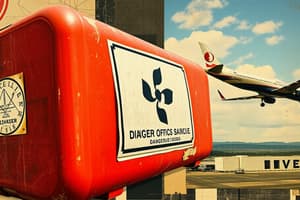Podcast
Questions and Answers
Which of the following best defines dangerous goods?
Which of the following best defines dangerous goods?
- Items that are listed in the IATA Dangerous Goods Regulations
- Items that are capable of posing a hazard to health, safety, property, or the environment and are listed or classified according to the IATA Dangerous Goods Regulations (correct)
- Articles or substances that pose a hazard to health, safety, property, or the environment
- Items that are classified according to the IATA Dangerous Goods Regulations
What determines whether an item is considered a dangerous good according to the IATA Dangerous Goods Regulations?
What determines whether an item is considered a dangerous good according to the IATA Dangerous Goods Regulations?
- The item's potential to cause harm (correct)
- The item's size
- The item's weight
- The item's value
Which of the following statements is true about dangerous goods?
Which of the following statements is true about dangerous goods?
- They are only listed if they are classified according to the IATA Dangerous Goods Regulations
- They can be either listed or classified according to the IATA Dangerous Goods Regulations (correct)
- They are neither listed nor classified according to the IATA Dangerous Goods Regulations
- They are only classified if they are listed in the IATA Dangerous Goods Regulations
Under what circumstances can exemptions be granted from the provisions of the DGR?
Under what circumstances can exemptions be granted from the provisions of the DGR?
Which national aviation authorities can grant exemptions from the provisions of the DGR?
Which national aviation authorities can grant exemptions from the provisions of the DGR?
What is the condition for granting exemptions from the provisions of the DGR?
What is the condition for granting exemptions from the provisions of the DGR?
Which of the following is NOT a condition for granting exemptions from the provisions of the DGR?
Which of the following is NOT a condition for granting exemptions from the provisions of the DGR?
Study Notes
Dangerous Goods Definition
- Dangerous goods are substances or materials that can pose a risk to health, safety, or the environment during transportation.
Determining Dangerous Goods
- According to the IATA Dangerous Goods Regulations, an item is considered a dangerous good if it meets certain criteria, including its physical and chemical properties, and its potential to cause harm.
Characteristics of Dangerous Goods
- Dangerous goods can be hazardous, flammable, toxic, corrosive, or explosive, and may also be radioactive or infectious.
Exemptions from DGR Provisions
- Exemptions from the provisions of the DGR can be granted under certain circumstances, such as when the goods are not likely to cause harm during transportation.
- National aviation authorities can grant exemptions from the provisions of the DGR.
- The condition for granting exemptions is that the goods do not pose a significant risk to health, safety, or the environment.
- Exemptions are not granted if the goods are forbidden or restricted by the IATA Dangerous Goods Regulations.
- The process of granting exemptions involves a thorough evaluation of the risks associated with the transportation of the goods.
Studying That Suits You
Use AI to generate personalized quizzes and flashcards to suit your learning preferences.
Description
Test your knowledge on dangerous goods and their classification with this quiz. Learn about the articles and substances that can pose hazards to health, safety, property, and the environment. Explore the IATA Dangerous Goods Regulations and enhance your understanding of this important topic.




